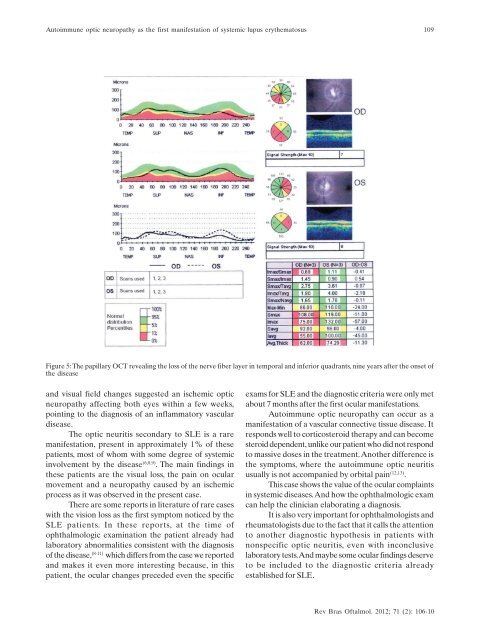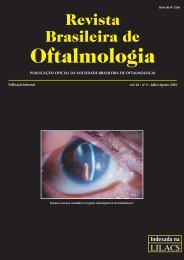Mar-Abr - Sociedade Brasileira de Oftalmologia
Mar-Abr - Sociedade Brasileira de Oftalmologia
Mar-Abr - Sociedade Brasileira de Oftalmologia
You also want an ePaper? Increase the reach of your titles
YUMPU automatically turns print PDFs into web optimized ePapers that Google loves.
Autoimmune optic neuropathy as the first manifestation of systemic lupus erythematosus109Figure 5: The papillary OCT revealing the loss of the nerve fiber layer in temporal and inferior quadrants, nine years after the onset ofthe diseaseand visual field changes suggested an ischemic opticneuropathy affecting both eyes within a few weeks,pointing to the diagnosis of an inflammatory vasculardisease.The optic neuritis secondary to SLE is a raremanifestation, present in approximately 1% of thesepatients, most of whom with some <strong>de</strong>gree of systemicinvolvement by the disease (6,8,9) . The main findings inthese patients are the visual loss, the pain on ocularmovement and a neuropathy caused by an ischemicprocess as it was observed in the present case.There are some reports in literature of rare caseswith the vision loss as the first symptom noticed by theSLE patients. In these reports, at the time ofophthalmologic examination the patient already hadlaboratory abnormalities consistent with the diagnosisof the disease, (8-11) which differs from the case we reportedand makes it even more interesting because, in thispatient, the ocular changes prece<strong>de</strong>d even the specificexams for SLE and the diagnostic criteria were only metabout 7 months after the first ocular manifestations.Autoimmune optic neuropathy can occur as amanifestation of a vascular connective tissue disease. Itresponds well to corticosteroid therapy and can becomesteroid <strong>de</strong>pen<strong>de</strong>nt, unlike our patient who did not respondto massive doses in the treatment. Another difference isthe symptoms, where the autoimmune optic neuritisusually is not accompanied by orbital pain (12,13) .This case shows the value of the ocular complaintsin systemic diseases. And how the ophthalmologic examcan help the clinician elaborating a diagnosis.It is also very important for ophthalmologists andrheumatologists due to the fact that it calls the attentionto another diagnostic hypothesis in patients withnonspecific optic neuritis, even with inconclusivelaboratory tests. And maybe some ocular findings <strong>de</strong>serveto be inclu<strong>de</strong>d to the diagnostic criteria alreadyestablished for SLE.Rev Bras Oftalmol. 2012; 71 (2): 106-10

















